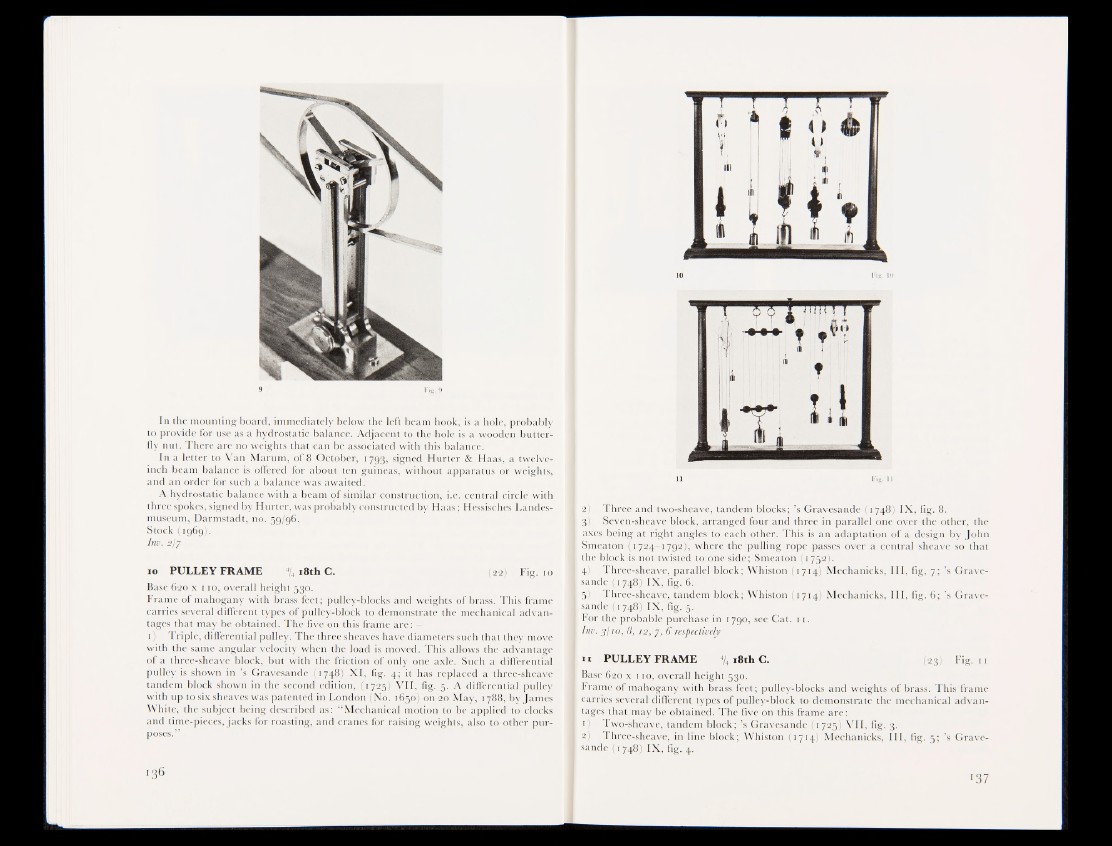
In the mounting board, immediately below the leftjteam hook, is a hole, probably
to provide for use as a hydrostatic balance. Adjacent to the hole is a wooden buttefi
fly nut. There are no weights that can be associated with this balance.
In a letter to Van Marum, of 8 October, 1793,' signed Hurter & Haas, a twelve-
inch beam balance is offered for about ten guineas?, without apparatus or weights,
and an order for such a! balance was awaited.
A hydrostatic balance with a beam of similar construction, i.e. central circle with
three spokes, signed by Hurter, was probably constructed by Haas; Hessisches I.andcs-
museum, Darmstadt, no. 59/96.
Stock (1969).
Inv. 2jj
10 PULLEY FRAME % 18th C. if jfe l) Fig. 10
Base 620 x 110, overall height 530.
Frame of mahogany with brass feet; pulley-blocks and weights of brass. This frame
carries several different types of pulley-block to demonstrate the mechanical advantages
that may be obtained. The five on this frame are: —
1) Triple, differential pulley. The three sheaves have diameters such that they move
with the same angular velocity when the load is moved. This allows the advantage
of a three-sheave block, but with the friction of only one axle. Such a differential
pulley is shown in ’s Gravesande (1748): XI, fig. 4; it has replaced a three-sheave
tandem block shown in the second edition, (xygjj; VII, fig. 5. A differential pulley
with up to six sheaves was patented in London (No. 1650/ on 20 May, 1788, by James
White, the subject being described as: “Mechanical motion to be applied to clocks
and time-pieces, jacks for roasting, and cranes for raising weights, also toaSther purposes.”
11 Fig. Itfjij
2M Three and two-sheave, tandem blocks; ’s Gravesande (1748) IX, fig. 8.
3) Seven-sheave block, arranged four and three in parallel one over the other, the
axes being at right angles to each other. This is an adaptation of a design by John
SmeatonHi 724—1792), where the pulling rope passes over a central sheave so that
the block is not twisted to one side; Smeaton (1752)5.
4) Thfeeitfieave, parallel block; Whiston (171.%) Mechanicks, III, fig, 7; ’s Grave-
sande (1748) IX, fig. 6.
5) Three-sheave, tandem block; Whiston |t7i4) Mechanicks, III, fig. 6; ’s Gravesande
(1748) IX, fig, 5.
For the probable purchase in 1790, see Cat. ijjs/iU
Inv. 3110, 8, 12, 7, 6 respectively
11 PULLEY FRAME % 18th C. (23) Fig. 11
Base 620 x 110, overall height 530.
Frame of mahogany with brass feet; pulley-blocks and weights of brass. This frame
carries several different types of pulley-block to demonstrate the mechanical advantages
that may be obtained. The five on this frame are:
1 W; Two-sheave, tandem block; ’s Gravesande (1725) VII, fig. 3.
2) Three-sheave, in line block; Whiston (1714) Mechanicks, III, fig. 5; ’s Gravesande
(1748) IX, fig. 4.